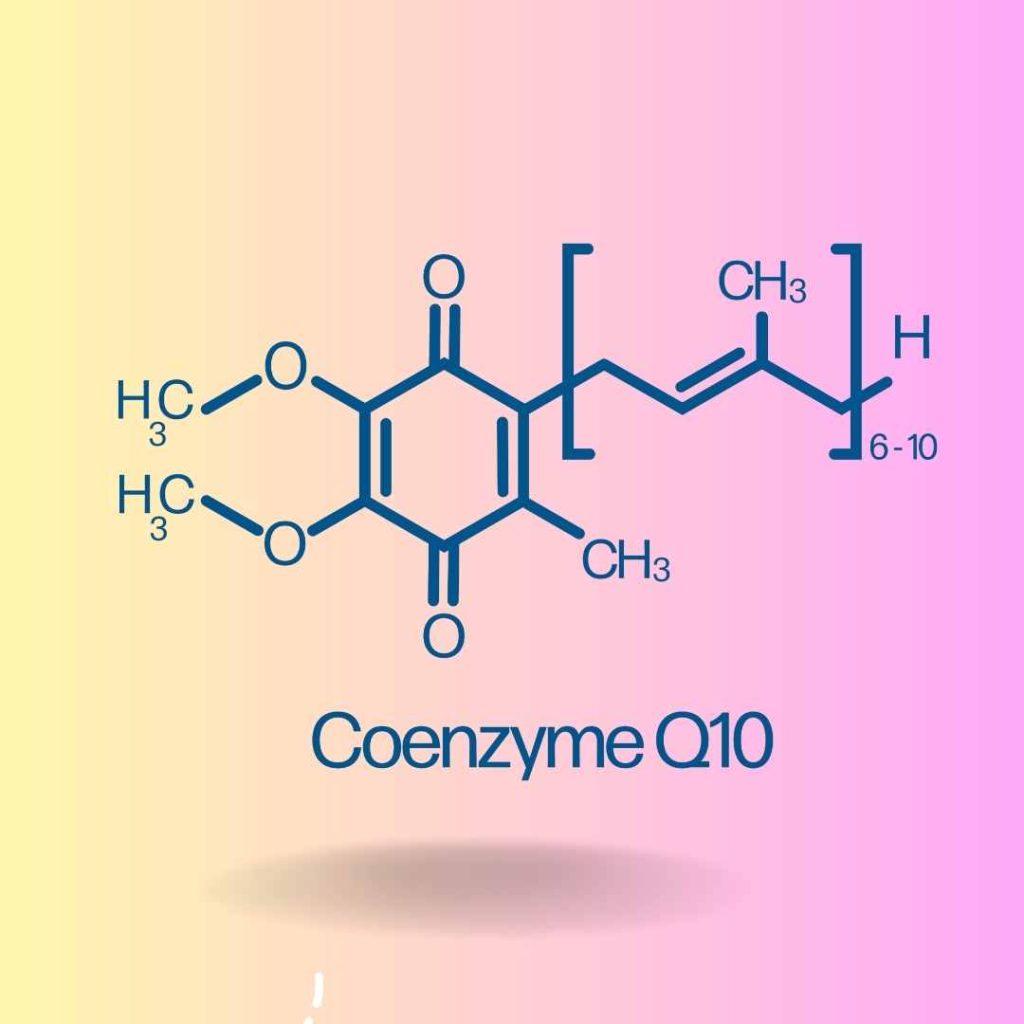
Coenzyme Q10 (CoQ10) is a fat-soluble, vitamin like benzoquinone compound (1, 2).
It presents in nearly all tissues, and it is a redox molecule, which exists in both a biochemically reduced form(ubiquinol-10) and an oxidised form (ubiquinone-10) in biological tissues (3,4).
Coenzyme Q10 plays an important role as a mobile electron carrier in the mitochondrial electron-transfer process of cellular respiration and energy production. It is also an important antioxidant (3,4,5).
Several studies stated that coenzyme Q10 was effective in cardiomyopathy, hypertension, angina pectoris, atherosclerosis, cancer, neurodegenerative disorders, periodontal diseases and diabetes (6 ,7).
Coenzyme Q10 is supplied from two sources; endogenous synthesis and exogenous sources (foods and supplements) (8, 9, 10).
Humans have the ability to produce coenzyme Q10. However, this ability starts declining at the age of 20 and coenzyme Q10 amounts in humans decrease more rapidly after the age of 40. Also, genetic mutation, some disseases like cancer and statin-type drugs can cause a decrease in coenzyme Q10 amount in serum or tissue; therefore, exogenous sources of coenzyme Q10 are important (3, 10, 11).
Meat, poultry and fish are the main coenzyme Q10 rich foods in accordance with a high content of mitochondria in muscle tissue (12, 13).
Ercan & El (2011) determined coenzyme Q10 contents in beef heart, liver and muscle as 109.97, 33.34, 23.47 μg/g, respectively (12). The average dietary of coenzyme Q10 is about 3–6 mg (4, 5, 14).
The suggested daily intake of coenzyme Q10 from exogenous sources varies from 30 to 100 mg for healthy people (15). Even with large amounts of coenzyme Q10 rich food products like beef heart in the diet; it would be difficult supply 100 mg/day (3).
References
- Bonakdar, R.A., Guarneri, E., 2005. Coenzyme Q10. American Family Physician 72 (6)
www.aafp.org/afp - Xia, S., Xu, S., Zhang, X., 2006. Optimization in the preparation of coenzyme Q10
nanoliposomes. Journal of Agricultural and Food Chemistry 54, 6358–6366 - Crane, F.L., 2001. Biochemical functions of coenzyme Q10. Journal of the American
College of Nutrition 20, 591–598 - Kubo, H., Fujii, K., Kawabe, T., Matsumoto, S., Kishida, H., Hosoe, K., 2008. Food
content of ubiquinol-10 and ubiquinone-10 in the Japanese diet. Journal of Food
Composition and Analysis 21, 199–210 - Mattila, P., Kumpulainen, J., 2001. Coenzyme Q9 and Q10: contents in foods and
dietary intake. Journal of Food Composition and Analysis 14, 409–417. - Ankola, D.D., Viswanad, B., Bhardwaj, V., Ramarao, P., Kumar, M.N.V.R., 2007.
Development of potent oral nanoparticulate formulation of coenzyme Q10
for treatment of hypertension: can the simple nutritional supplements be used
as first line therapeutic agents for prophylaxis/therapy? European Journal of
Pharmaceutics and Biopharmaceutics 67, 361–369 - Pravst, I., Zˇmitek, K., Zˇmitek, J., 2010. Coenzyme Q10 contents in foods and
fortification strategies. Critical Reviews in Food Science and Nutrition 50 (4),
269–280 - Overvad, K., Diamant, B., Holm, L., Hu` lmer, G., Mortensen, S.A., Stender, S., 1999.
Review coenzyme Q10 in health and disease. European Journal of Clinical
Nutrition 53, 764–770 - Oudshoorn, J.H., Lecluse, A.L.Y., Berg, R., Vaes, W.H.J., Laag, J., Houwen, R.H.J., 2006.
Decreased coenzyme Q10 concentration in plasma of children with cystic
fibrosis. Journal of Pediatric Gastroenterology and Nutrition 43 (5), 646–650. - Ercan P., El S.N., In vitro bioaccessibility of coenzyme Q10 in enriched yoghurts, International Journal of Food Science & Technology, 2012, 47:1986-1992
- Itagaki, S., Ochiai, A., Kobayashi, M., Sugawara, M., Hirano, T. & Iseki, K. (2010). Grapefruit juice enhance the uptake of coenzyme Q10 in the human intestinal cell-line Caco-2. Food Chemistry, 120, 552–555
- Ercan P., El S.N., Changes in content of coenzyme Q10 in beef muscle, beef liver and beef heart with cooking and in vitro digestion, Journal of Food Composition and Analysis, Journal of Food Composition and Analysis 24 (2011) 1136–1140
- Kagan, V.E., Quinn, P.T., 2001. Coenzyme Q: Molecular Mechanisms in Health and
Disease. CRC Press, United States of America, 390 p - Zˇmitek, J., Zˇmitek, K., Pravst, I., 2008. Improving the bioavailability of coenzyme Q10
from theory to practice. AgroFOOD Industry Hi-tech 19. - Pravst, I., Prosˇek, M., Wondra, A.G., Zˇ mitek, K. & Zˇ mitek, J. (2009). The stability of coenzyme Q10 in fortified foods. Acta Chime Slovenia, 56, 953–958
